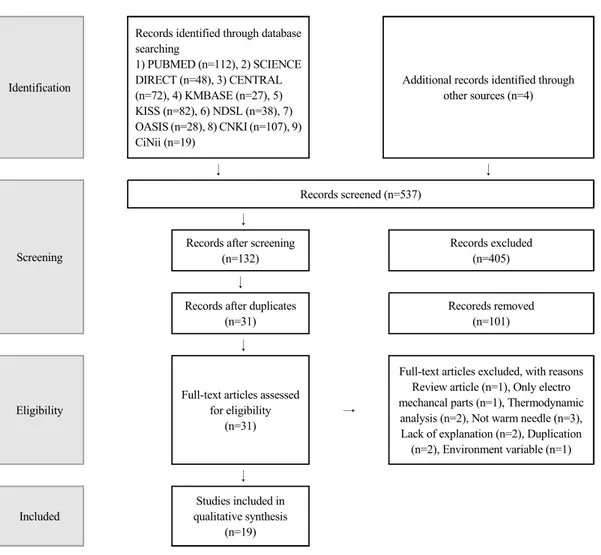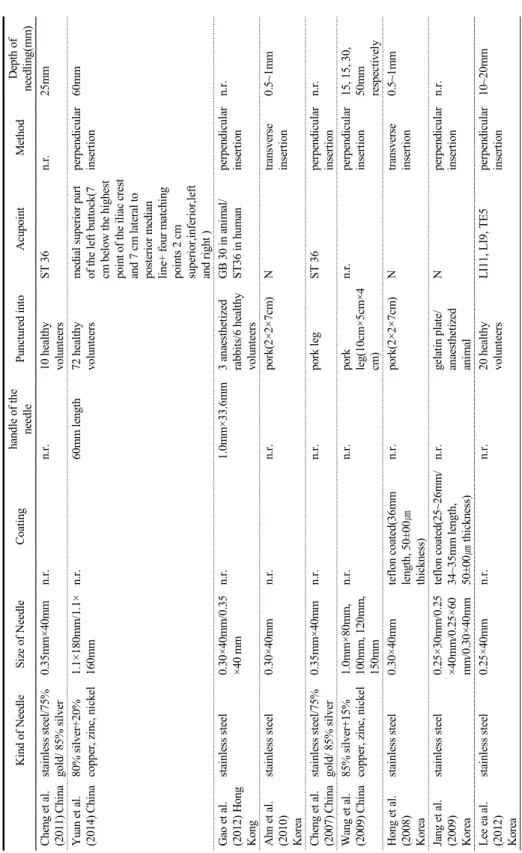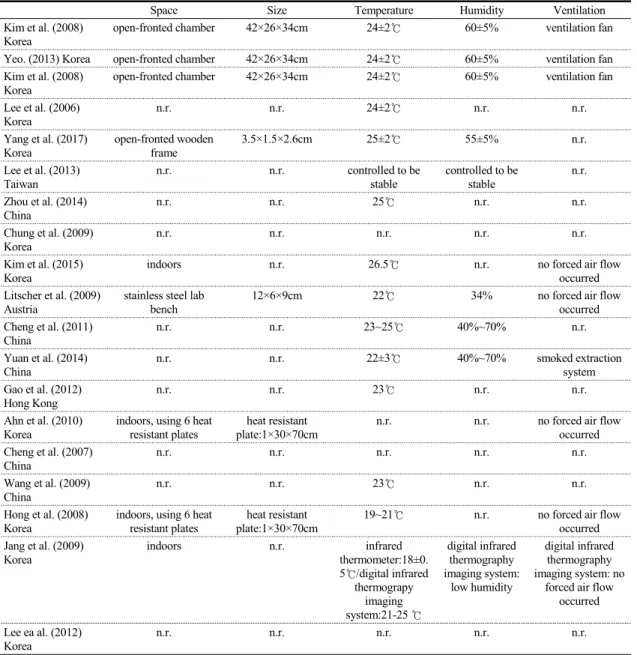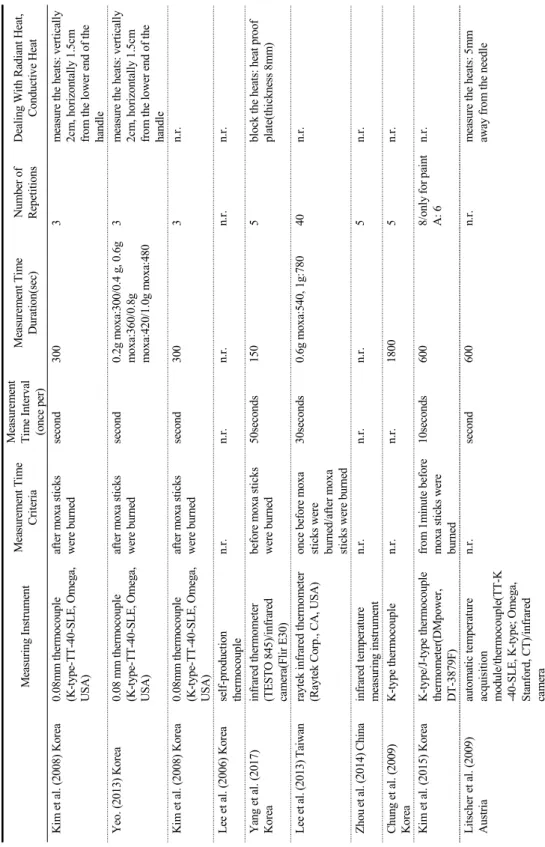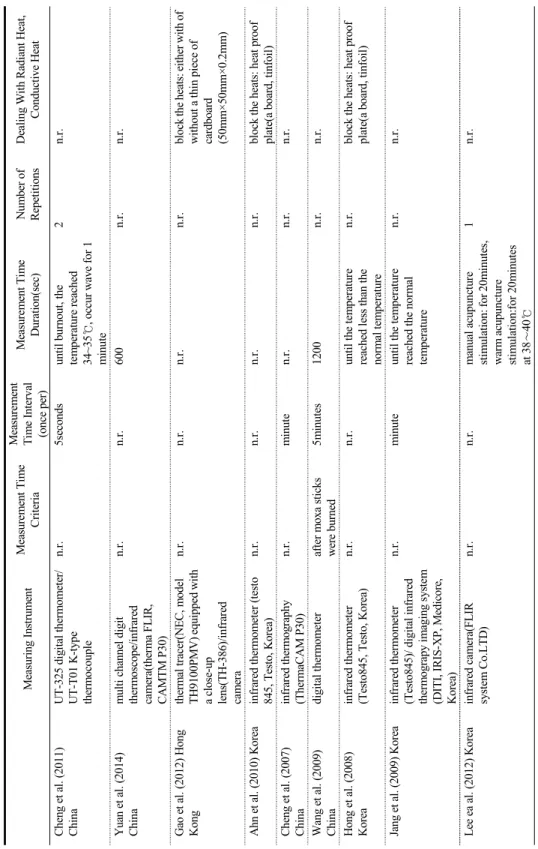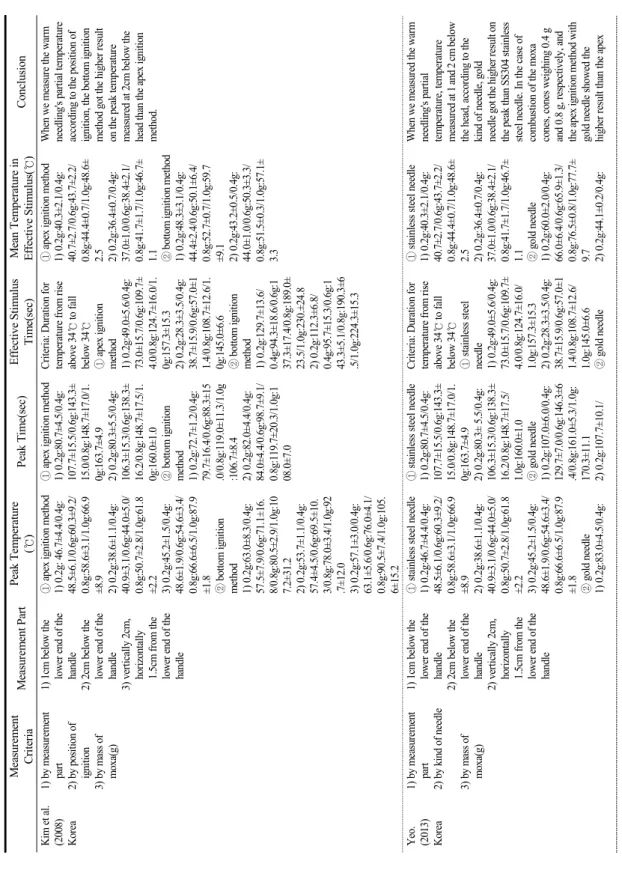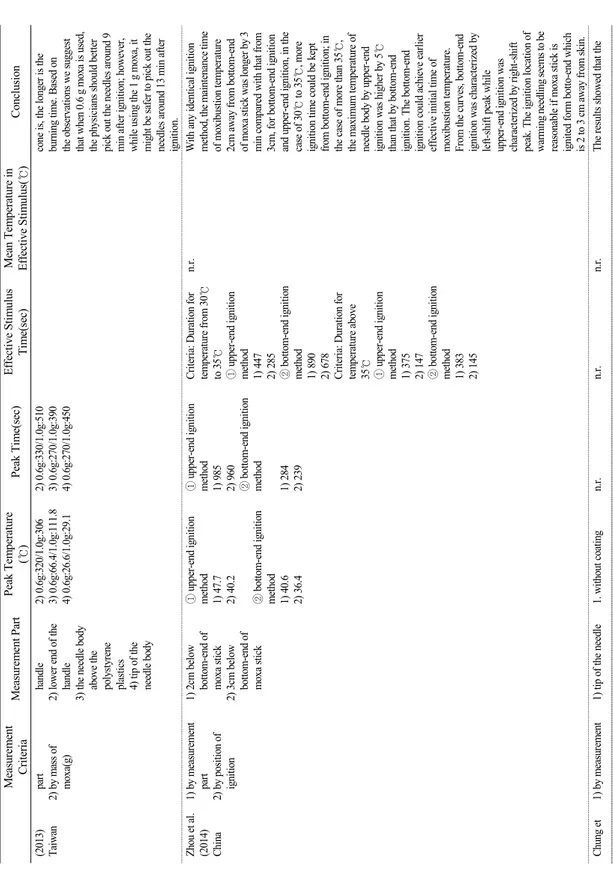온침의 온도변화 특성에 대한 문헌 고찰 연구
이주현1, 조효림2, 김선혜2, 이연선3, 박세원4, 문소리5, 정찬영6, 성원석2, 조현석2, 김경호3, 이병욱7,8, 김은정2*
1동국대학교 한의과대학, 2동국대학교 분당한방병원 침구의학과, 3동국대학교 일산한방병원 침구의학과, 4동국대학교 분당한방병원 사상체질과,
5동국대학교 분당한방병원 한방재활의학과, 6동국대학교 한의과대학 한의학연구소, 7동국대학교 한의과대학 원전의사학 교실, 8㈜동제메디칼 Review Article
⋅Received:2 August 2019 ⋅Accepted:23 August 2019
⋅Correspondence to:Eun-Jung Kim
Department of Acupuncture & Moxibustion Medicine, Dongguk University Bundang Oriental Hospital 268, Buljeong-ro, Bundang-gu, Seongnam-si, Gyeonggi-do, 463-865, Republic of Korea
Tel:+82-31-710-3751, E-mail:hanijjung@naver.com
A Review on the Characteristics of Temperature Variation in Warm Needle
Ju Hyun Lee1, Hyo Rim Jo2, Seon Hye Kim2, Yeon Sun Lee3, Se Won Park4, So Ri Moon5 Chan Yung Jung6 Won Suk Sung2, Hyun Seok Cho2, Kyung Ho Kim3, Byung Wook Lee7,8
Eun-Jung Kim2*
1College of Korean Medicine, Dongguk University
2Dep. of Acupuncture & Moxibustion Medicine, Dongguk University Bundang Oriental Hospital
3Dep. of Acupuncture & Moxibustion Medicine, Dongguk University Ilsan Oriental Hospital
4Dept. of Sasang Constitutional Medicine, Dongguk University Bundang Oriental Hospital
5Dep. of Korean Rehabilitation Medicine, Dongguk University Bundang Oriental Hospital
6Institute of Oriental Medicine, College of Korean Medicine, Dongguk University
7Dept. of Medical Classics and History, College of Korean Medicine, Dongguk University
8Dongje Medical Co., Ltd
Objectives: The purpose of this study is to organize the research methods and results of studies related to the temperature of the warm needle for systematic utilization of warm needling technique.
Methods: This study used the databases of nine (Pubmed, Science Direct, Cochrane Central, 4 Korean databases, CNKI, CiNii) to analyze temperature-related studies of the warm needle from 2000 to June 2019.
Results: A total of 19 papers were included. Of these, 15 were used for mugwort, 2 for high frequency, and 1 for both mugwort and high frequency, and the other one for a ceramic heater. The maximum temperature rises as the amount of moxibustion increases. It is also affected by the density of moxa and the ignition part. There were 16 papers using stainless steel needles and 4 papers using a needle made of gold or silver to compare. In the area of the needle, the closer it is to moxibustion, the hotter it is. Compared to stainless steel needles, gold and silver needles showed almost twice the temperature. The effects of environment and radiant heat should be considered during warm needle procedures.
Conclusions: There are various experimental methods such as warm needle technique materials, methods, measuring parts, measuring instruments, etc. The results were also very diverse. When setting the heating source, ignition part, size of moxibustion, etc. of warm needles, it should be implemented in a way that takes safety and validity into account. Considerations for temperature characteristics, radiant heat, etc. of warm needles will be needed when making warm needle apparatus.
Key Words : warm needle, warm acupuncture, temperature, heat, thermal property
서 론
온침(溫鍼) 요법이란 호침(毫鍼)을 체내에 자입한 후 침병(鍼柄) 또는 침미(鍼尾)에 쑥을 부착하고 불을 붙여 열 자극을 가해 치료하는 방법이다1). 자침을 한 후, 뜸의 온열 자극을 같이 주어 경맥을 통하도록 하 고 기혈을 흐르게 하여, 경락과 기혈이 막힌 것을 치 료한다. 『黃帝內經素問』 調經論篇에서 지금의 온침이 라고 여겨지고 있는 燔鍼이라는 용어가 언급되었고2), 온침이라는 용어는 『傷寒論』에서 최초로 언급되었다
3).
온침을 통한 임상적 호전 예는 널리 알려져 있다.
관절염4), 요추 추간판탈출증5) 등과 같은 통증질환에 주로 사용되고, 동물실험을 통해 통증의 초기보다는 통증의 후기에 효과가 있음이 밝혀졌다6). 이 외에 기 능회복의 효과가 있어 뇌졸중 환자에게 쓰여 일상생 활 활동을 향상시키고7) 면역기능과 관련한 치료효과 도 보고된 바 있다8).
온침의 치료기전은 국소 조직 내에 고온 영역이 활성화되는 열요법(thermotherapy)과 유사하여, 신진 대사를 촉진하고 혈관을 확장하며 말초신경의 흥분 성을 감소시킨다는 보고가 있다7). Cheng 등의 연구9) 에서는 침체를 통해 방사열이 전도되어 경혈점의 깊 은 조직을 자극하고 표면을 따뜻하게 함으로써 그 효과가 있다고 주장하고 있다. 또한 온침을 사용하면 그 효과가 집중되어 경혈 순환을 빠르게 정상화시킨 다는 주장도 있다6).
온침은 뜸과 침을 같이 다루어야 하기 때문에 시 술이 일반 침, 혹은 일반 뜸만 사용하는 치료법보다 복잡하여 그 시술방법에 따라 자극량이 달라져 효과 의 차이가 있을 수 있다. 이러한 가운데 온침 관련 연구가 체계적으로 이루어지기 위해서는 온침의 주 요 기전인 열특성에 기반한 적절한 실험방법에 대한 고찰 및 온침 시술의 온도에 대한 정리가 필요하다.
본 연구는 온침에 관련된 기존 연구에서 특히 열적 특성에 주목하여 살펴보고자 한다. 그리고 이를 바탕
으로 온침 기기 개발의 기초자료로 활용하고자 한다.
연구대상과 방법
본 연구는 온침의 체계적 활용을 위한 온침의 온 도와 관련된 연구들의 연구방법과 결과를 정리하는 것을 그 목적으로 한다. 본 논문은 전통적인 고찰 (review) 논문 형식이다.
본 연구는 2000년부터 2019년 6월까지 국내외 온 침의 온도관련 연구를 분석하기 위해 Pubmed, Science direct, The Cochrane Central Register of Controlled Trials, 한국의학논문데이터베이스(KMbase), Korean Studies Information Service System(KISS), National Digital Science Library(NDSL), Oasis, China National Knowledge Infrastructure(CNKI), CiNii의 검색시스템을 이용하였다. 2000년부터 2019 년 6월까지 게재된 논문을 대상으로 “(Warm Acupuncture OR Warm Needle) AND (Temperature OR Heat), 온침 AND (온도 OR 열전달)”을 검색어 로 사용하였다.(Figure 1)
2019년 7월 2일에 검색을 시작하여 검색된 533편 의 논문에서 문헌 선정 과정은 선정기준과 배제기준 에 따라서 2단계에 의해 진행되었다. 1단계는 연구 제목과 초록을 검토하였다. 2단계는 문헌의 전문을 보면서 본 연구 주제와의 적합성을 검토하였다.
1단계에서 연구 제목과 초록을 검토하여 질병과 관련된 임상 연구, 2000년 이전 논문인 경우 제외하 였다. 2단계에서 문헌의 전문을 보면서 적합성을 검 토하여 문헌고찰 연구는 제외하였고 온침요법의 온 도와 관련된 연구만 조사하기 위해 온침의 전자기기 학적 내용, 열역학적 분석, 온도 외에 다른 기류와 같은 요인을 추가하여 분석한 연구 등은 포함하지 않았다. 온침이 아닌 경우, 실험과 결과에 대한 설명 이 부족한 경우, 다른 논문과 중복되는 경우 또한 제 외하였다.
결 과
검색시스템을 통해 검색된 533편의 논문 외에 hand searching과 검색한 논문의 참고문헌을 바탕으 로 4개의 논문이 추가되어 총 537편의 논문을 앞서 정한 기준에 따라 분석하였다. 총 19편의 논문을 최 종 선정하였으며 이중 국내 논문이 11편, 중국논문이 5편, 대만, 오스트리아, 홍콩 논문이 각각 1편이었다.
그리고 발표연도에 따라 분류하자면 2009년에 4편으 로 가장 많은 논문이 발표되었다. 그 다음으로 2008
년과 2013년이 각각 3편, 2014년이 2편, 2006, 2007, 2010~2012, 2015, 2017년에 각각 1편의 논문 이 발표되었다.
가열원에 따른 분포를 살펴보면 최종 선정된 19편 의 논문 중 15편은 쑥뜸, 2편은 고주파, 1편은 쑥뜸 과 고주파를 모두 다루었고 나머지 1편은 ceramic heater를 사용하였다. 쑥뜸의 모양에 있어서는 총 3 가지 모양이 있고, 원추형이 6편, 원통형이 6편, 구형 이 2편이었고, 2편에서는 쑥뜸의 모양에 대한 언급이 없었다. 원추형의 경우에는 한국에서 시행된 3개의
Identification
Records identified through database searching
1) PUBMED (n=112), 2) SCIENCE DIRECT (n=48), 3) CENTRAL (n=72), 4) KMBASE (n=27), 5) KISS (n=82), 6) NDSL (n=38), 7) OASIS (n=28), 8) CNKI (n=107), 9) CiNii (n=19)
Additional records identified through other sources (n=4)
↓ ↓
Screening
Records screened (n=537)
↓ Records after screening
(n=132)
Records excluded (n=405)
↓
Records after duplicates (n=31)
Recoreds removed (n=101)
↓
Eligibility
Full-text articles assessed for eligibility
(n=31)
→
Full-text articles excluded, with reasons Review article (n=1), Only electro mechancal parts (n=1), Thermodynamic analysis (n=2), Not warm needle (n=3), Lack of explanation (n=2), Duplication (n=2), Environment variable (n=1)
↓
Included
Studies included in qualitative synthesis
(n=19)
Fig. 1. Process of the Selecting Data (PRISMA Flow chart)
논문에서는 내경 43mm, 높이 41mm의 성형틀에서 반죽되었고, 그 외에는 그냥 반죽되었다. 원통형의 경우에는 반죽되거나 시중에 파는 중앙이 뚫린 형태 의 쑥뜸이 사용되었고, 구형의 경우는 그냥 반죽되었 다. 뜸의 무게는 0.1~5.0g까지 다양했는데, 0.5~1.0g 의 뜸 무게로 실험한 논문이 총 15편으로 각각 3편 이상으로 많았고, 그 중에서도 1.0g이 5편으로 가장 많았다. 그 다음으로는 0.5g이 4편으로 많았다. 원추 형의 모양일 때는 0.5g과 1.0g일 때가 각각 3편으로 가장 많았다. 높이에 있어서는 원통형으로 15mm인 것이 가장 많았다. 쑥뜸의 점화는 주로 향을 이용하 여 이루어졌고(5편), 1편의 논문에서는 토치를 이용 하여 점화가 이루어졌다. 대부분 상단에서 점화가 이 루어졌고, 이 상단에서 점화가 이루어진 것과 비교하 기 위해 하단에서도 점화한 논문이 2편 있었다. 다른 1편의 논문에서는 외측면에서 점화가 이루어졌다. 뜸 과 침 자입 대상의 표면 사이 거리는 15~35mm에 모든 논문이 분포되었고, 이 중 15mm, 25mm, 30mm 가 각각 3편씩으로 가장 많았다.(Table 1) 고주파는 300kHz 또는 150kHz를 1~20mA로 20분 또는 30분 자극하는 형태였다.(Table 2)
Stainless steel을 재질로 하는 침이 16편으로 가장 많았고, 나머지 3개는 은침을 사용한 논문이었다.
Stainless steel침과 비교하기 위하여 금이나 은을 재 질로 하는 침이 사용된 논문이 4편이었다. 침의 규격 은 0.25X40mm이 7편으로 가장 많았고, 그 다음으로 0.30×40mm이 5편, 0.35X40mm이 4편으로 많았다.
침자법은 돈육에 자침할 때 횡자한 논문 2편과, 침자 법에 대해 언급하지 않은 1편 외에는 모두 직자법이 쓰였다. 바늘의 깊이는 5mm가 3편으로 가장 많았고, 그 다음이 15mm, 0.5~1mm가 2편으로 많았다.
(Table 3)
쑥뜸 연소 특성 분석을 위해 앞면이 개방되어 있 는 방이나 벤치를 이용한 논문이 5편 있었다. 또한 쑥뜸을 이용한 논문에서는 환기를 위해서 fan을 설 치하여 연기가 배출되도록 하였다. 실험환경에서 온
도는 18~26℃로 상온에서 이루어졌다. 습도는 40~70%
사이의 일반적인 평균습도에서 실험이 이루어졌 다.(Table 4)
측정기기에 있어서는 열전쌍(thermocouple)이 9편 으로 가장 많고, 열전쌍의 type 중에서는 K-type (thermocoupleK-type-TT-40-SLE, Omega, USA)이 7편으로 가장 많았다. 그 다음으로 적외선 온도계 (infra-red thermometer)가 7편으로 가장 많았다. 적 외선 온도계는 testo(testo 845, Testo, Korea)가 4편 으로 가장 많이 쓰였다. 그 다음으로 많이 쓰인 측정 기가 적외선 카메라로 5편의 논문이 있었다. 측정 시 간 기준은 뜸이 점화가 된 전, 후를 기준으로 이루어 졌고, 측정시간 간격은 1초에 한번이 4편으로 가장 많았다. 측정시간은 300초와 600초가 각각 3편으로 가장 많았다. 반복횟수는 3회와 5회가 각각 3편으로 가장 많았다. 복사열을 차단한 논문이 4편으로 가장 많았고, 침체에서 조금 떨어져서 복사열을 측정한 논 문은 3편이었다.(Table 5)
Table 6과 7은 모두 결과치를 정리한 표이다. 결 과값 측정 기준은 침체의 부위별로 나눈 것이 15편 으로 가장 많았고, 그 다음으로 뜸의 질량별로 나눈 것이 5편, 침의 재질별과 침의 크기(길이 및 굵기)별 로 나눈 것이 4편으로 많았다. 침체의 부위별로는 침 첨을 측정한 논문이 6편으로 가장 많았고, 그 다음이 침체가 자입 대상과 맞닿은 부분이 5편이었고, 그 다 음으로는 침병에서 1cm아래, 2cm아래가 각각 4편으 로 많았다. 그 다음으로는 침첨에서 1cm, 2cm위의 부위와, 뜸의 가장 아랫면에서 1cm, 2.5cm 떨어진 부위가 3편으로 많았다. 가장 많이 측정된 부위인 침 첨의 결과값을 살펴보면, 뜸 무게 1.0g에서 측정된 것이 3편으로 가장 많았고, 이들 최고온도의 평균값 은 24.25℃, 그 다음으로 3.0g을 측정한 두 결과값의 평균은 23.45℃, 5.0g을 측정한 두 결과값의 평균은 24.28℃였다. 이들 논문에서의 침의 재질은 모두 스 테인리스 침이었다.(Table 6, 7)
Table 1. Summary of Moxibustion Used in Warming Needling First authors(year)
Origin Shape Weight
(g)
Height (mm)
Diameter
(mm) Ignition
Distance between the Moxibustion Block and the Surface(mm) Kim et al. (2008)
Korea cone 0.2
0.4 0.6 0.8 1.0
10.4 15.7 20.4 23.9 25.2
11.4 22.4 25.0 28.5 33.3
at the apex/bottom using
incense 15
Yeo. (2013) Korea cone 0.2
0.4 0.6 0.8 1.0
10.4 15.7 20.4 23.9 25.2
11.4 22.4 25.0 28.5 33.3
at the apex using incense 15
Kim et al. (2008) Korea cone 0.8 n.r. n.r. at the apex using incense 15
Lee et al. (2006) Korea ball 0.50±0.01 n.r. 20 at the upper end n.r.
Yang et al. (2017) Korea cylinder n.r. 8 7 n.r. 20
Lee et al. (2013) Taiwan cylinder 0.6 1.0
10 15
10 13
at the lateral side 35
Zhou et al. (2014) China cylinder n.r. n.r. n.r. at the upper end/bottom end 20, 30
Kim et al. (2015) Korea cylinder n.r. 15 n.r. using torch 30
Litscher et al. (2009)
Austria cylinder n.r. n.r. n.r. top n.r.
Cheng et al. (2011) China n.r. 1.2
1.5 10
13 18
18 n.r. n.r.
Yuan et al. (2014) China ball 1.3 n.r. n.r. at the upper end with 1ml
of 95% ethanol n.r.
Gao et al. (2012) Hong Kong
cylinder 1.70±0.05 15 12 at the upper end 20, 25, 30 in
anaesthetized rabbits/
25, 30, 35 in human Ahn et al. (2010) Korea cone 0.1
0.3 0.5 1.0 3.0 5.0
n.r. n.r. at the apex using incense n.r.
Cheng et al. (2007) China cone 0.5 n.r. n.r. n.r. n.r.
Wang et al. (2009) China n.r. n.r. 15 n.r. n.r. n.r.
Hong et al. (2008) Korea cone 0.5 1.0 3.0 5.0
n.r. n.r. at the apex using incense n.r.
n.r.: not reported
Table 2. Summary of Other Heating Source Used in Warm Needling
Kind of Heating Source kHz mA for Duration Distance between the Heating Source and the Surface Hong et al. (2008) Korea high frequency warm needling
device
300 1mA, 2.5mA, 5mA, 10mA, 20mA for 20minutes
X Jang et al. (2009) Korea high frequency warm needling
device
300 1mA, 2.5mA, 5mA, 10mA, 20mA for 30 minutes
X Lee ea al. (2012) Korea high frequency warm needling
device
150 n.r. for 20 minutes X
Chung et al. (2009) Korea ceramic heater N N 25mm
n.r.: not reported; N: inappropriate
Table 3. Summary of Needle Kind of NeedleSize of NeedleCoatinghandle of the needlePunctured intoAcupointMethodDepth of needling(mm) Kim et al. (2008) Korea stainless steel0.25×40mmn.r.n.r.center of the disposable paper cup Nperpendicular insertion5mm Yeo. (2013) Koreastainless steel/95%gold+5% white gold
0.25×40/0.53×35 mmn.r.1.14×33mm 100% silvercenter of the disposable paper cup Nperpendicular insertion5mm Kim et al. (2008) Korea
stainless steel0.25×40mmn.r.n.r.center of the disposable paper cup Nperpendicular insertion5mm Lee et al. (2006) Korea
stainless steel/95%gold+5% white gold 0.25×40mm/0.53 ×35mmsilicon coated1.14X33mm 100% silverplateNperpendicular insertionn.r. Yang et al. (2017) Korea
stainless steel0.3×40mm/0.5×4 0mm/0.8×40mmn.r.removedfixed frameNperpendicular insertionn.r. Lee et al. (2013) Taiwan
stainless steel1.5inch 32gaugen.r.n.r. polystyrene plasticsNperpendicular insertionn.r. Zhou et al. (2014) Chinastainless steel0.35mm×40mmn.r.n.r.n.r.Nperpendicular insertionn.r. Chung et al. (2009) Korea silver0.6×60mmnone coated/Al2O3 ceramic coated(25mm length, 100㎛ thickness) n.r.n.r.Nperpendicular insertionn.r. Kim et al. (2015) Korea
stainless steel0.25×40mmceramic pigment coated(15, 20, 25, 30mm length)/aluminum silicate coated(30mm length)/manicure coated(30mm length) n.r.styrofoam plateNperpendicular insertionn.r. Litscher et al. (2009) Austria
stainless steel0.30×50mmsilicone coated25mm length metalholder made of a good thermal insulator/6 healthy volunteers CV 6perpendicular insertionn.r.
Table 3. Summary of Needle (Continued) Kind of NeedleSize of NeedleCoatinghandle of the needlePunctured intoAcupointMethodDepth of needling(mm) Cheng et al. (2011) Chinastainless steel/75% gold/ 85% silver0.35mm×40mmn.r.n.r.10 healthy volunteersST 36n.r.25mm Yuan et al. (2014) China80% silver+20% copper, zinc, nickel1.1×180mm/1.1× 160mmn.r.60mm length72 healthy volunteersmedial superior part of the left buttock(7 cm below the highest point of the iliac crest and 7 cm lateral to posterior median line+ four matching points 2 cm superior,inferior,left and right )
perpendicular insertion60mm Gao et al. (2012) Hong Kong
stainless steel0.30×40mm/0.35 ×40 mmn.r.1.0mm×33.6mm3 anaesthetized rabbits/6 healthy volunteers GB 30 in animal/ ST36 in humanperpendicular insertionn.r. Ahn et al. (2010) Korea
stainless steel0.30×40mmn.r.n.r.pork(2×2×7cm)Ntransverse insertion 0.5~1mm Cheng et al. (2007) Chinastainless steel/75% gold/ 85% silver0.35mm×40mmn.r.n.r.pork legST 36perpendicular insertionn.r. Wang et al. (2009) China85% silver+15% copper, zinc, nickel1.0mm×80mm, 100mm, 120mm, 150mm n.r.n.r.pork leg(10cm×5cm×4 cm) n.r.perpendicular insertion15, 15, 30, 50mm respectively Hong et al. (2008) Korea
stainless steel0.30×40mmteflon coated(36mm length, 50±00㎛ thickness) n.r.pork(2×2×7cm)Ntransverse insertion 0.5~1mm Jang et al. (2009) Korea
stainless steel0.25×30mm/0.25 ×40mm/0.25×60 mm/0.30×40mm teflon coated(25~26mm/ 34~35mm length, 50±00㎛ thickness) n.r.gelatin plate/ anaesthetized animal Nperpendicular insertionn.r. Lee ea al. (2012) Korea
stainless steel0.25×40mmn.r.n.r.20 healthy volunteersLI11, LI9, TE5perpendicular insertion10~20mm n.r.: not reported; N: inappropriate
온침은 침과 뜸을 결합한 치료법으로 한국을 포함 한 아시아 국가에서 가장 많이 사용되는 한의학적 치료법 중 하나이다10).
온침은 과도한 열 자극으로 인한 화상과 침 자극 으로 인한 피하혈종과 같은 부작용이 생길 수 있다
11). 하지만 온침은 침병에 뜸을 부착시키기 때문에 피부와의 거리가 일반 뜸 치료보다 멀어 화상의 위 험을 줄일 수 있고, 고온으로 달구어 사용하는 화침
Table 4. Summary of Experimental Environment
Space Size Temperature Humidity Ventilation
Kim et al. (2008) Korea
open-fronted chamber 42×26×34cm 24±2℃ 60±5% ventilation fan
Yeo. (2013) Korea open-fronted chamber 42×26×34cm 24±2℃ 60±5% ventilation fan
Kim et al. (2008)
Korea open-fronted chamber 42×26×34cm 24±2℃ 60±5% ventilation fan
Lee et al. (2006) Korea
n.r. n.r. 24±2℃ n.r. n.r.
Yang et al. (2017) Korea
open-fronted wooden frame
3.5×1.5×2.6cm 25±2℃ 55±5% n.r.
Lee et al. (2013)
Taiwan n.r. n.r. controlled to be
stable controlled to be
stable n.r.
Zhou et al. (2014) China
n.r. n.r. 25℃ n.r. n.r.
Chung et al. (2009) Korea
n.r. n.r. n.r. n.r. n.r.
Kim et al. (2015) Korea
indoors n.r. 26.5℃ n.r. no forced air flow
occurred Litscher et al. (2009)
Austria
stainless steel lab bench
12×6×9cm 22℃ 34% no forced air flow
occurred Cheng et al. (2011)
China
n.r. n.r. 23~25℃ 40%~70% n.r.
Yuan et al. (2014) China
n.r. n.r. 22±3℃ 40%~70% smoked extraction
system Gao et al. (2012)
Hong Kong
n.r. n.r. 23℃ n.r. n.r.
Ahn et al. (2010) Korea
indoors, using 6 heat resistant plates
heat resistant plate:1×30×70cm
n.r. n.r. no forced air flow
occurred Cheng et al. (2007)
China
n.r. n.r. n.r. n.r. n.r.
Wang et al. (2009) China
n.r. n.r. 23℃ n.r. n.r.
Hong et al. (2008) Korea
indoors, using 6 heat resistant plates
heat resistant plate:1×30×70cm
19~21℃ n.r. no forced air flow
occurred Jang et al. (2009)
Korea
indoors n.r. infrared
thermometer:18±0.
5℃/digital infrared thermograpy
imaging system:21-25 ℃
digital infrared thermography imaging system:
low humidity
digital infrared thermography imaging system: no
forced air flow occurred Lee ea al. (2012)
Korea
n.r. n.r. n.r. n.r. n.r.
n.r.: not reported; N: inappropriate
고 찰
Table 5.Summary of Measurement Instrument and Methods Measuring InstrumentMeasurement Time Criteria Measurement Time Interval (once per)
Measurement Time Duration(sec)Number of RepetitionsDealing With Radiant Heat, Conductive Heat Kim et al. (2008) Korea0.08mm thermocouple (K-type-TT-40-SLE, Omega, USA)
after moxa sticks were burnedsecond3003measure the heats: vertically 2cm, horizontally 1.5cm from the lower end of the handle Yeo. (2013) Korea0.08 mm thermocouple (K-type-TT-40-SLE, Omega, USA) after moxa sticks were burnedsecond0.2g moxa:300/0.4 g, 0.6g moxa:360/0.8g moxa:420/1.0g moxa:480
3measure the heats: vertically 2cm, horizontally 1.5cm from the lower end of the handle Kim et al. (2008) Korea0.08mm thermocouple (K-type-TT-40-SLE, Omega, USA)
after moxa sticks were burnedsecond3003n.r. Lee et al. (2006) Koreaself-production thermocouplen.r.n.r.n.r.n.r.n.r. Yang et al. (2017) Koreainfrared thermometer (TESTO 845)/infrared camera(Flir E30)
before moxa sticks were burned50seconds1505block the heats: heat proof plate(thickness 8mm) Lee et al. (2013) Taiwanraytek infrared thermometer (Raytek Corp., CA, USA)once before moxa sticks were burned/after moxa sticks were burned
30seconds0.6g moxa:540, 1g:78040n.r. Zhou et al. (2014) Chinainfrared temperature measuring instrumentn.r.n.r.n.r.5n.r. Chung et al. (2009) KoreaK-type thermocouplen.r.n.r.18005n.r. Kim et al. (2015) KoreaK-type/J-type thermocouple thermometer(DMpower, DT-3879F)
from 1minute before moxa sticks were burned
10seconds6008/only for paint A: 6n.r. Litscher et al. (2009) Austriaautomatic temperature acquisition module/thermocouple(TT-K -40-SLE, K-type; Omega, Stanford, CT)/infrared camera
n.r.second600n.r.measure the heats: 5mm away from the needle
Table 5.Summary of Measurement Instrument and Methods(Continued) Measuring InstrumentMeasurement Time Criteria Measurement Time Interval (once per)
Measurement Time Duration(sec)Number of RepetitionsDealing With Radiant Heat, Conductive Heat Cheng et al. (2011) ChinaUT-325 digital thermometer/ UT-T01 K-type thermocouple
n.r.5secondsuntil burnout, the temperature reached 34~35℃, occur wave for 1 minute
2n.r. Yuan et al. (2014) Chinamulti channel digit thermoscope/infrared camera(therma FLIR, CAMTM P30)
n.r.n.r.600n.r.n.r. Gao et al. (2012) Hong Kongthermal tracer(NEC, model TH9100PMV) equipped with a close-up lens(TH-386)/infrared camera
n.r.n.r.n.r.n.r.block the heats: either with of without a thin piece of cardboard (50mm×50mm×0.2mm) Ahn et al. (2010) Koreainfrared thermometer (testo 845, Testo, Korea)n.r.n.r.n.r.n.r.block the heats: heat proof plate(a board, tinfoil) Cheng et al. (2007) Chinainfrared thermography (ThermaCAM P30)n.r.minuten.r.n.r.n.r. Wang et al. (2009) Chinadigital thermometerafter moxa sticks were burned5minutes1200n.r.n.r. Hong et al. (2008) Koreainfrared thermometer (Testo845, Testo, Korea)n.r.n.r.until the temperature reached less than the normal temperature
n.r.block the heats: heat proof plate(a board, tinfoil) Jang et al. (2009) Koreainfrared thermometer (Testo845)/ digital infrared thermograpy imaging system (DITI, IRIS-XP, Medicore, Korea)
n.r.minuteuntil the temperature reached the normal temperature
n.r.n.r. Lee ea al. (2012) Koreainfrared camera(FLIR system Co.LTD)n.r.n.r.manual acupuncture stimulation: for 20minutes, warm acupuncture stimulation:for 20minutes at 38∼40℃
1n.r. n.r.: not reported
